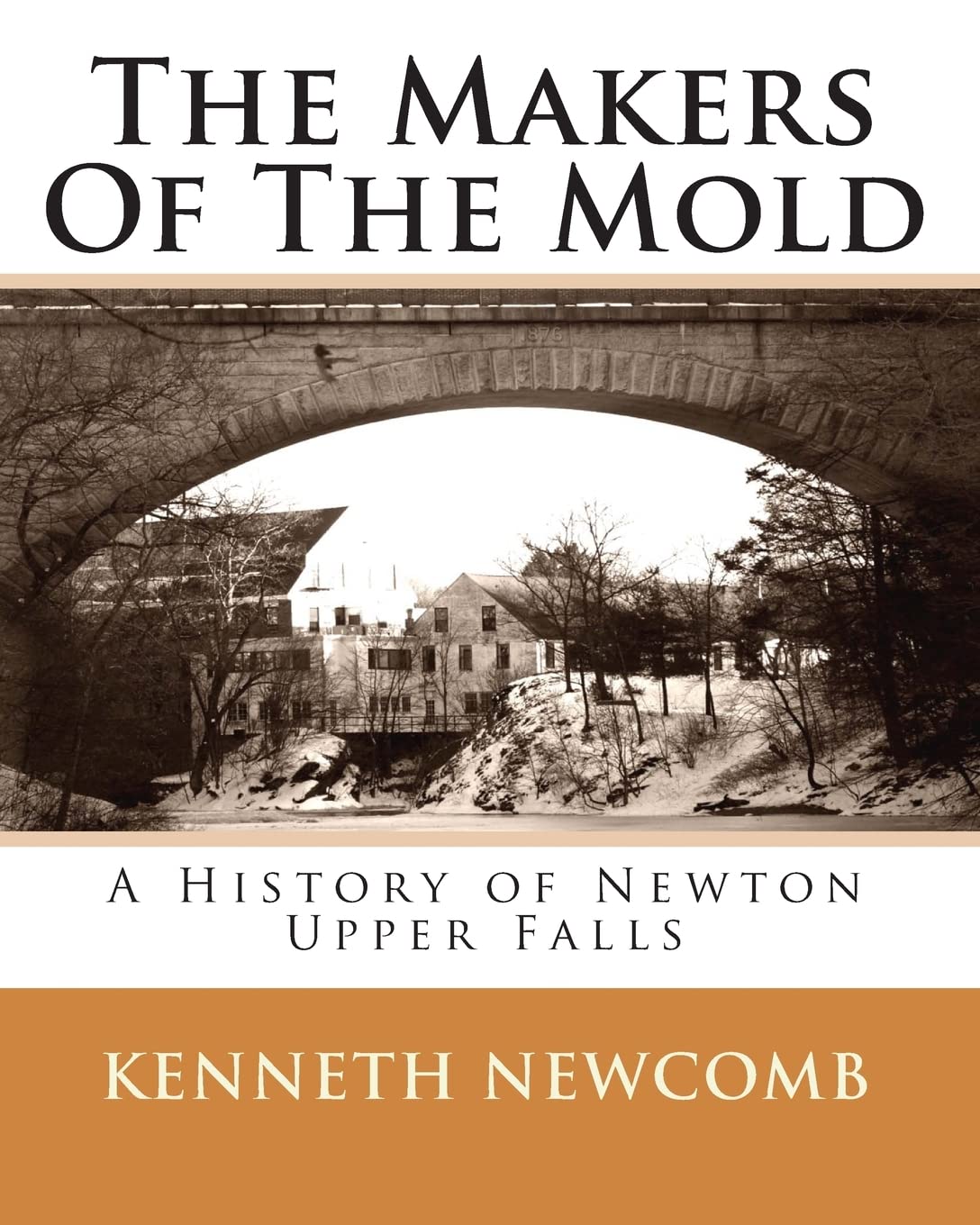ROBERT B. McLAUGHLIN
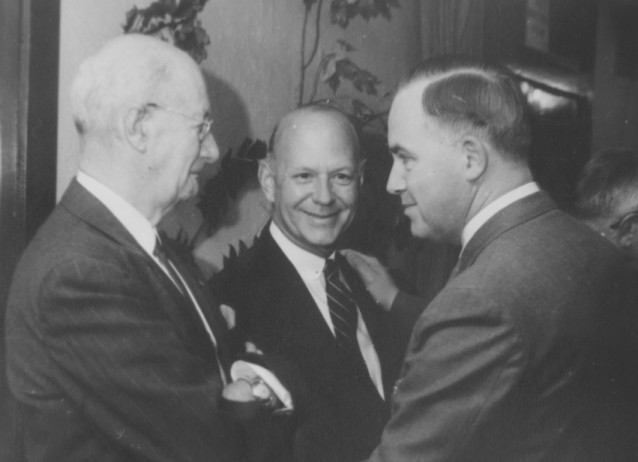
Robert B. McLaughlin, to whom this book is dedicated, wrote a short unpublished history of Newton Upper Falls that was based mostly on his personal recollections of the days he spent in the village. It was an inspiration to the author in developing the more elaborate coverage contained in this volume. Mr. McLaughlin, an outstanding resident of the village for many years, was born in Scotland in 1881. He came with his parents to the United States at the age of seven, settling in Newton Upper Falls in 1888. He was educated in the Newton schools, continued his education at Wentworth Institute and Lowell Technical School and following graduation, and took a position teaching mathematics in a Connecticut school. He later took employment with the B. F. Sturtevant Company of Readville where he remained for many years. His last position with this firm was Safety Engineer, which led to him becoming the president of the Massachusetts Safety Council. Mr. McLaughlin served as president of the Newton Upper Falls Improvement Association and was also an organizer of Boy Scout Troop 12 of this village. He enjoyed all types of community activities and often appeared in dramatic as well as minstrel show presentations. In 1940 he joined Clarence Churchill (the principal of the Emerson School) and Mrs. Ragna Hovgaard of the City of Newton Recreational Department in developing the first city wide Halloween parties schools, thus inaugurating a program that was to become a model for similar affairs across the nation.
As a member of both the Boston and Newton Chapters of the American Red Cross, Mr. McLaughlin became widely known as a top grade instructor in First Aid. His services were in demand by the local fire and police departments and many other civic groups, particularly during World War II.
He was married in 1911 to Helen (Nellie) Crowley who shared her husband’s enthusiasm for participating in community affairs.
Mr. McLaughlin died December 26, 1970 at the age of 89.
FREDERIC BARDEN
Frederic Barden was born in Dover, Massachusetts. In early life he was employed in working and rolling iron, first in his native town and later in Wareham, Massachusetts. Still later, he was engaged in setting up large mills in Pembroke. He lived in Newton for more than 30 years, erecting mills and carrying on an extensive business which provided employment to many (mostly in Newton Upper Falls where he owned and operated many mills, and also owned a great deal of real estate). He was a representative to the General Court for two sessions and was a very active churchman in the Channing Religious Society at Newton Corner. His last residence was the beautiful and prominent mansion at Newton Upper Falls, built by Dr. Samuel Whitney and afterward owned and occupied by Dr. A. D. Dearborn. (It was later owned by Josiah B. Jewell, Dr. William McOwen and, finally, by the Mary Immaculate of Lourdes Church. The house was moved to make way for the church and today serves as the St. Elizabeth Center. Ed.)
He died September 25, 1817 at the age of seventy-one, leaving his widow but no children.
THE CHENEY FAMILY
John and Martha Cheney settled in Roxbury about 1635. They moved to Newbury in 1636 where their four sons and five daughters were born. A grandson, John, moved to Newton Upper Falls in 1702 and built a home on what is now Mechanic Street (see description under “Old Houses and Buildings”). Another grandson, Joseph, moved to Newton at about the same time and in 1702 married Sarah, daughter of Captain Noah Wiswall. He inherited a portion of Wiswall’s land that was located in the southwestern part of Newton. A third grandson, John Cheney, also came to Newton and built his home in 1732 on the lower end of Mechanic Street (in the present William Street area). There were many children born to these three men and their wives, and subsequent marriages joined them with many pioneer Newton families. Five Cheneys served in the Revolutionary War, with three taking part in the engagement at Lexington. Worth mentioning is the fact that while three of John and Martha’s grandchildren left Newbury for Newton, a great grandson, Benjamin, moved from Newton to Connecticut. In 1724 he was operating a grist mill in Oxford Parish, East Hartford which later became the town of Manchester. This was the beginning of a long period of industrial dominance in Manchester by the Cheney family which did not end until 1957. From a humble beginning in a small mill built in 1838 they earned world renown as the producers of the famous “Cheney Silks.” In 1924 they were operating the largest silk plant in the world, and in 1925 Cheney silk was the first American product to be put on exhibition in the Louvre Museum in Paris. Despite the fact that a silk mill operated in Upper Falls from 1884 until 1960 there is no evidence that the local Cheneys were involved in its operations.
Joseph Cheney Jr., who was the great-grandson of John and Martha, was married his second wife, Mary Toser, granddaughter of Edward Jackson, and in the early 1700s they built or purchased a home on Prospect Hill. It was on this property that Otis Pettee built his home in 1828.
THE CLARK FAMILY
Since a great deal of information regarding this family has been included earlier in this book, it will not be repeated here. In 1688 John Clark established the first mill on the river in Newton at Newton Upper Falls although he apparently did not build a home here, rather ‘commuting’ daily from his home in Newton Centre. However, it appears that his son William (who with his brother, John, had inherited their father’s property) did built a home in Upper Falls very early in the eighteenth century; it is recorded to have burned on March 18, 1729.
An account appearing in S. F. Smith’s history involving some of the Clarks in the Indian Wars is of interest and we include a portion of it here:
“In 1779 a small group of residents went to live in Sudbury, Canada (near Bethel, Maine). By 1781 there were ten families living in the town.
Indians in the area were quite friendly at first but later became hostile. On August 26, 1781, six Indians from Canada, armed with guns, tomahawks and scalping knives took Nathaniel Seger, Benjamin Clark, Lieutenant Jonathan Clark of Newton and Captain Eleazer Twitchell prisoner and plundered their homes.
Benjamin and Jonathan Clark were cousins; Benjamin was the son of Norman Clark; Jonathan the son of William Clark, Jr. and both men were grandsons of William Clark, Sr. and great-grandsons of Newton Upper Falls mill owner, John Clark.
The Indians loaded down their captives with heavy packs of plundered articles and then, binding their hands together, ordered them to march. They proceeded to a place called Peabody’s Patent (now Gilead, Maine) where they took James Pettengill prisoner and ordered them all to march toward Canada. Pettengill was without shoes and could not travel so the Indians murdered him. They continued their way through Shelburne, New Hampshire, crossed the Androscoggin, plundered a house nearby, shot one man and took another prisoner. At this point they allowed Lieut. Jonathan Clark to go back. Being twelve years older than Benjamin, it is thought the Indians regarded him as too weak to endure the hardships of the march.
They continued on their march to Canada and reached Lake Umbagog on the fifth day after they were taken prisoners. In Canada they were taken to an Indian village, where seventy Indian warriors were assembled; who rejoiced greatly over the prisoners, scalps and plunder. The men here were treated with great indignity. The red-skins cut off the hair of Benjamin Clark, painted him, made him wear Indian garb and then surprisingly gave him his liberty among them. The men were afterwards taken to Montreal, where they suffered. incredible hardships for forty days, and were then sent forty-five miles farther up the river. There they were detained until the surrender of Lord Cornwallis that signaled the end of the Revolutionary War. The object of the Indians seems to have been to deliver them up as prisoners of war to the British authorities, or perhaps to secure a reward for their capture.
The men were finally taken to Quebec, and after a detention of fifteen months, full of hardships and suffering, were set at liberty. They sailed for Boston, landing at Dorchester Point. They arrived in Newton, much to the astonishment and joy of their relatives and friends who had not heard a word. from them since their capture in Bethel.”
Many of the Clark, Parker and Marean families of the Upper Falls area later settled in central Massachusetts communities such as Barre, Rutland. and Hubbardston, and some of their descendants were known by this writer. The Clark family possesses a genealogy that clearly indicates its connection with the pioneer Clark family of Newton Upper Falls. It is, incidentally, a family to which the author is related.
DARIUS and CYRUS COBB
Perhaps the most outstanding contributors to the arts from this village were the Cobb twins, Cyrus and Darius who lived for many years on Boylston Street, Cyrus at #1129 and Darius at #1137. Because of the influence of these families, the Boylston Street Hill was known as Cobb’s Hill for a long time. The twins were the sons of Rev. Sylvanus Cobb, D.D. and Eunice (Hale) Cobb, and were born August 6, 1834 in the old Ralph Waldo Emerson house in Malden, Massachusetts. They were educated in the Boston Schools, attended Norway (Maine) Liberal Institute and later graduated with high honors from Boston Latin School. Cyrus continued his education at Boston University and graduated from Law School in 1873. They both enlisted in the Civil War and saw action while serving with the 44th Massachusetts Regiment. On January l, 1866 they were married by their father in a double wedding ceremony to sisters; Cyrus to Laura N. Lillie and Darius to Emma Lillie. The two girls were lineal descendants of John Alden of Pilgrim fame.
Darius was a portrait and landscape painter, poet, singer and lecturer. He was considered to be one of America’s better historical painters. His paintings in that category include Washington at Dorchester Heights which was hung in the Memorial Continental Hall in Washington. The Old Drummer of the Revolution was placed in the old State House in Boston and the Boston Tea Party was hung in the hall of the Ancients and Honorables. The Death of Cuchullan was accepted and placed in Boston College. He did portraits of Phillips Brooks, Governor John A. Andrew (hung at the State House) and Rufus Choate (among others). Locally, his portrait of Ralph Waldo Emerson was once the proud possession of Emerson School.
From the TOWN CRIER of June 22, 1906:
“Last evening eleven scholars graduated from the Ralph Waldo Emerson school amid the applause and admiration of the parents and friends and profuse floral tributes.
The diplomas were given by Miss Cora Stanford Cobb of the School committee, after which, in words graceful and fitting, Miss Cobb presented to the school a valuable, life sized work of her father, Mr. Darius Cobb. The picture is said by people of our village who knew Emerson, to be the striking likeness of the ‘Concord sage. ‘ “1
Principal Hodges for the school expressed his thanks for the gift, which is to hang in the library. He spoke of the work and character of Emerson and what it ought to mean to the scholars of the school. Mr. Darius Cobb from the audience was given a royal welcome after which he made a few remarks, alluding to the respect, confidence and love which the village had shown him during his residence of nearly thirty years. He said that the love of the children was ample thanks for the “pain of art” taken in painting the picture….”
It was religious paintings, however, for which Darius Cobb was better known. His first was entitled Judas, followed by Christ Before Pilate, Abraham, and a magnificent head of Christ called The Master. This painting was completed in 1917 when the artist was 83 years of age. He had worked on it for 34 years before considering it finished. Unfortunately, a few years later it was destroyed by fire.
Darius and his wife had seven children; four daughters, Lillie Alden, Cora Stanwood, Estelle and Edith and three sons, Stanwood, Percival B. and Frederick. Frederick resided in Upper Falls and was shipping agent for the Pettee Machine Works. His home was on Rockland Place in the old John A. Gould House.
Cyrus Cobb practiced law for six years but later devoted full time to the arts of painting and sculpturing. His paintings were of a historical nature and included portraits of General U. S. Grant, Abraham Lincoln and a canvas entitled Warren at the Old South which is hung at the Old South Meeting House in Boston. His sculptured pieces include a head entitled, The Celtic Bard, a heroic bas-relief Prospero and Miranda, a bust of General Butler, a bust of Phillips Brooks and one of local interest, that of Reverend S. F. Smith, author of the patriotic hymn America. This latter piece was placed in the State House. His most noted work was the Soldiers Monument located on Cambridge Common. His design for this monument was selected from about 40 others.
Cyrus and his wife had five children; three daughters: Grace, Elsie, and Florence and two sons, Francis S. and Ernest. Ernest purchased the old Cunningham estate on Richardson Road in 1918 from which he and his wife, Bertha, successfully operated the Arlo Publishing Company which featured children’s books.
It should be noted that Eunice Hale White Cobb, the mother of Darius and Cyrus, founded the first woman’s club in America called the “Ladies Physiological Institute” which promoted health and fitness.
In one more reference to Darius Cobb’s numerous historical paintings, we note from a news item appearing in the TOWN CRIER of May 5, 1911 that 10,000 postal cards of Mr. Cobb’s painting of the Last Comrade’s Final Tribute were being printed for circulation through the country. If anyone has one of these cards in their possession we would appreciate seeing it.
THE ELLIOT-PERKINS FAMILIES
In the latter days of the eighteenth century the Elliot family exerted a great deal of influence on the village of Newton Upper Falls. Elliot Street, one of the main thoroughfares of the village, perpetuates the name. We will not attempt to give a complete genealogical background of the family. However, there were two Elliots who had an influence on the village, father and son, both bearing the name of Simon. This fact seems to have confused our early historians and has led to some distortion of the record of achievement of each man.
Simon, the father, was a well-to-do Boston trader and tobacco dealer who purchased, in two transactions (1778 & 1782) the old mill site in Upper Falls. As indicated in the chapter regarding industry in the village, he laid the foundation, through his small but varied industrial complex, for the more ambitious establishment that followed.
His son, inheritor of the property, was known as General Elliot, a title received through service in the state militia. Records show he was born in 1762 and died in 1832. His wife was the former Eliza Barnard (born 1768, died 1852). Although General Elliot continued his father’s business, some unlucky investments and a general business recession (partially created by the War of 1812 which closed European markets to the United States) more or less influenced him to sell the property to his brother-in-law, Thomas H. Perkins. Very little is known of his private life although he spent part of his early days here in the village. He had maintained family control over the Newton mills, and it is recorded. that he built a home in the village “which served to facilitate frequent family excursions to ‘The Falls.’ ” We know that he had a least one child, a son (name unknown), as we discovered through an interesting story regarding an episode in his life. (See OLD HOUSES AND BUILDINGS)
We are indebted to Carl Seaburg and Stanley Paterson’s book MERCHANT PRINCE OF BOSTON, Colonel T.H. Perkins, 1764-1854, for most of the following information regarding this remarkable man who was associated with the village of Upper Falls for over 50 years. For 27 years of this period he was actively engaged in operating the Elliot Manufacturing Company.
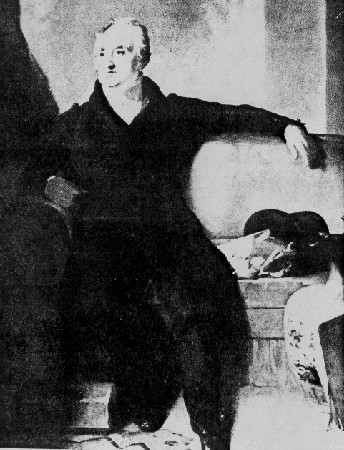
Thomas H. Perkins was born in Boston December 15, 1764. His maternal grandfather, Thomas Handasyd Peck, was a merchant and his father followed the same calling. Thomas was the second son and was only six years old at the time of his father’s death. While his mother was a woman of great business ability and continued to manage her husband’s business successfully, she had eight children to raise, so it was for this reason that in 1770 Thomas Perkins went to live with his grandfather, the man for whom he was named. He was prepared for college by private tutors but never attended. He preferred a mercantile career and in 1799 entered the employ of Messrs. Shattuck, one of the most prominent business firms in Boston, remaining with them until 1785. It was at this point that he entered into the shipping business in partnership with his brother James.
On March 25, 1788 he married 20 year old Sally Elliot ( one of the two daughters of Simon Elliot (incorrectly identified by Simon Elliot’s biographers as his only daughter. See INDUSTRY). The marriage put him in close association with his wife’s brother, General Simon Elliot and prior to purchasing his interest in the mills at Upper Falls they embarked on a few business ventures together. One of these included an investment in the first theatre in Boston (the Federal) which was erected February 3, 1794. His early association with the shipping industry ultimately led to a lucrative career in shipping to the West Indies as well as Europe and even to maintaining an office in Canton, China. An involvement in fur trading on the West Coast resulted in achieving a monopoly of the handling and selling of sea otter pelts, a very lucrative venture.
Too young to participate in the Revolutionary War, Thomas nevertheless was involved in a rather dangerous venture during the French Revolution in 1794 by sailing one of his ships into a harbor in France and spiriting George Washington Lafayette (Washington’s godchild) on board and back to asylum in this country. This led to a personal invitation by Washington to visit Mount Vernon in 1796 for a one-night stay and to enjoy the president’s hospitality. It is said that at one point Washington offered him the position of Secretary of the Navy in the nation’s first presidential cabinet. Mr. Perkins graciously declined on the grounds that his own fleet was larger and, presumably, more important to him. It is interesting to note that in this period many seacoast towns were claiming to be the home of the nation’s first navy even though a list of those making up the president’s cabinet did not contain a Secretary of the Navy. Thomas was elected to the state senate in 1805 and for the following 20 years was a member of one branch or the other of the legislature. However, most of his time was spent in the senate.
Thomas was one of the promoters of the Quincy Granite Railway (the first in the country) which was organized to supply the granite for the building of Bunker Hill monument, a prospect in which he also took an active part. He held the first organizational meeting in his home for the building of a general hospital in Boston, which later became known as the Massachusetts General Hospital. He also became one of its more generous financial backers. However, it was felt that an asylum for the mentally retarded was needed first, with the result that a facility was built which eventually became the McLean Hospital.
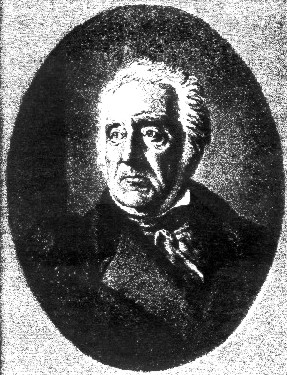
In 1826 he and his brother, James Perkins, contributed half the sum of $30,000 that was needed for an addition to the Boston Athenaeum. The old Boston Athenaeum Gallery of Art was moved to James Perkin’s home and an addition was needed to the house to contain the collection. At that time it was called. the “Academy of Fine Arts”. It was the philanthropic interest of James and Thomas that led to the building of its formal home, the present prestigious Museum of Fine Arts.
When Thomas built his new home on Province Court in 1832, he gave his mansion on Pearl Street (valued at $50,000) to the New England Institution for Education of the Blind with the provision that the additional sum of $50,000 be subscribed by the public for maintaining the Institute. Mr. Perkins had been in England and learned first hand of the excellent work being done with the blind by Samuel Gridley Howe, and had succeeded in persuading Mr. Howe to come to this country to work with the institution. Mr. Howe’s work attracted so much attention that an increase of students demanded larger quarters, with the result that a new institution was opened in South Boston under the name The Perkins Institute and. Massachusetts Asylum for the Blind. In 1910 the Stickney estate in Watertown was purchased for the final home of this organization which was to gain world-renown as The Perkins Institute for the Blind. Thomas showed great interest the Institute, and though he was a hard ‘bargaining business man, was caring enough to have the Gospel of St. John published in a small Braille volume suitable for teaching the art of reading to the blind. In 1799 Perkins had purchased 61 acres in Brookline and began to build a country house called the “Mansion House” which became a show place. It was here on January 11, 1854 that Thomas Handasyd Perkins died after 90 years of an exciting and fruitful life. As a mark of esteem, both branches of the Massachusetts Legislature adjourned the day of the funeral.
Incidentally we might recall that it was Howe’s wife, Julia, who wrote the stirring “Battle Hymn of the Republic.”
It might also be recalled that Sally (Elliott) Perkins’ daughter, Mary Ann Perkins, married Thomas Graves Gary and their daughter, Elizabeth Gary Agassiz, was the first president of Radcliffe College. Also Sarah (Elliot) Perkin’s daughter, Eliza, married Samuel Cabot. Their son, James Elliot Cabot, was the official biographer of Ralph Waldo Emerson, a commission which met with the warm endorsement of the noted poet and philosopher before his death.
THE EVERETT FAMILY
(See also under chapter “THE PEOPLE” )
The Everett family was another very prominent family in early Upper Falls, moving here from Foxboro. The Everetts originally emigrated from England about 1634-35. The family was represented in Upper Falls by three brothers, Joseph, Nathaniel W. and Cyrus. Their mother was Abigail (Pettee) Everett, sister of Otis Pettee. Nathaniel married a Winslow, Deborah Ann, in 1849 at Newton Upper Falls which drew the three families together.
One of the more famous Everetts who often visited the village was a cousin, Edward Everett, who was a noted scholar, statesman and orator with an outstanding public record. After a short term at Phillips Academy he entered Harvard at the age of 13, graduating at 17 with highest honors. Daniel Webster, once his teacher, later became a lifelong friend. In 1813 at the age of 19 he was pastor of Brattle Street Church, but two years later he returned to Harvard as professor of Greek Literature. In 1825 he entered the political life and over a period of 35 years served the state as its congressman, senator and governor. He also served the nation as U.S. Minister of the Court of Saint James in Great Britain as well as Secretary of State in Washington under President Millard Fillmore. In the midst of this he managed to occupy the chair of the President of Harvard for a brief period. His oratorical prowess was exhibited when, in later life, he traveled up and down the eastern United States extolling the virtues of George Washington, raising $90,000 of which $68,000 went to a desperately needed restoration of Mount Vernon. During the Civil War he was a close friend and confidant of President Lincoln. When Upper Falls resident Dr. Joseph Huckins Warren, a member of the Warren family of Revolutionary War fame, married Caroline Everett (daughter of Joseph C, Everett), it was no doubt Edward Everett’s influence with President Lincoln that secured for Dr. Warren the position of personal physician to the president during the Civil War (See under ‘Dr. Warren’ “THE PEOPLE” chapter). The reader may recall that Edward was the orator who shared the platform with Lincoln at the dedication of the cemetery at Gettysburg and who congratulated Lincoln after he had made his famous “Four score and seven years ago ….” speech saying something to the effect, “You said more in two minutes than I did in two hours!”
THE GOULD FAMILY
The Goulds are an old New England family, originating in England and arriving in this country at Charlestown, Massachusetts on the ship DEFENSE in 1635. The Newton Upper Falls branch of the family was headed by Major John Allen Gould I (born in Milton, Massachusetts October 4, 1785 and died July 9, 1860 ). He was married to Rebecca Gay on May 29, 1810 at Walpole, Massachusetts, and they probably settled in Walpole early in the nineteenth century. There is no record of John Allen Gould I ever residing in Newton Upper Falls. However, he kept a diary where he recorded his family’s activities until two months before his death in 1860. Most of the following is taken from that journal, and only members of the Gould family associated with Newton Upper Falls are included here. This also applies to family information taken from other sources.
The first member of Major Gould’s family to arrive in Newton Upper Falls was John Allen Gould II in October, 1833. He was born February 27, 1815 at Walpole and died September 2, 1894 at Newton Upper Falls.
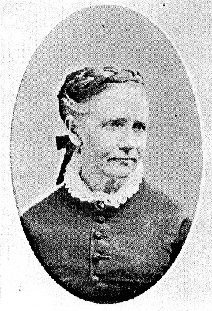

On March 5, 1835 John Allen II’s brother, George, (born November 11, 1819) “went to work for Otis Pettee of Newton Upper Falls to learn the business of Machinist.” On September 8, 1845 his father records, “My son George was married to Almira Andrews of Charleston, Mass.” On February 8, 1847 their first child, Ella Rebecca, was born. On July 18, 1851 Rebecca was joined by a brother, George Frederick. On December 31, 1856 another daughter, Mary Elizabeth, joined the family.
On May 30, 1848 George’s father wrote, “My son George bought a house and some land at Newton Upper Falls for which he paid $950. The house is not entirely finished for a dwelling and will therefore require an outlay of two or three hundred dollars to put it in condition suitable for a residence. George has to this time lived in a hired house.” An 1874 city atlas (Newton’s first) shows, on a Newton Upper Falls map, the house of “G. Gould” to be what is now 58-60 High Street. It is still standing.

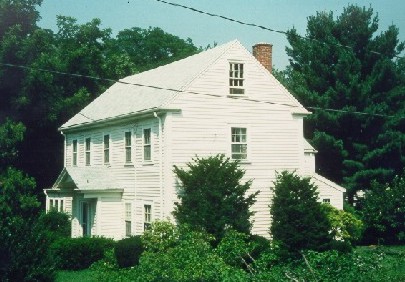
In 1841, another brother, Charles, left his home in Walpole for Newton Upper Falls to learn the “machine business.” He would serve an apprenticeship “on the woodwork of machinery at Otis Pettee’s, Newton Upper Falls.” (An important note must be made here regarding Charles Gould, son of John Allen Gould I. Beginning at this point most of Charles’s activities were kept in a separate record and included earlier in the chapter VILLAGE LIFE with the activities of the Winslow family as he was very closely associated with some of its members, especially those involved with the Boston-Newton Joint Stock Associates in their 1849 gold-seeking trek to California).
High Street in Upper Falls was laid out in 1837. A map (c.1850) shows Rockland Place only extending as far as John A. Gould Jr.’s house (now 49 Rockland Place) so John A. II’s house was built or acquired sometime between 1837and 1850. This is confirmed by an entry in his father’s diary, dated April 24, 1845, “My son John Allen purchased a house and about 3 or 4 acres of land at Newton Upper Falls for a residence for himself and family.” Note: This seems to be in conflict with his address shown in the 1868 town directory. However, Rockland Place is not shown in the street directory portion of this same directory.
In 1839 John A. II married Nancy Paine Hartshorn, daughter of Richard Hartshorn at Walpole, and “commenced housekeeping at Newton.” An 1868 Newton Town Directory (its first) indicates that John A. I, along with brother George, was employed at Frederick Barden’s rolling mill located at the lower dam of the Charles River at the Worcester Turnpike (now Boylston Street), his occupation shown as clerk; and George’s as a machinist. Both of their home addresses were listed as “High (St.) near Winter.”
The first of John A. II’s six children was Charles Allen Gould, born July l, 1842 but who died at a young age a year later on February 16, 1843, with his burial at Walpole. The second child, Nancy Jane Gould was born January 8, 1844 and died on October 3, 1849; also buried at Walpole. The occasion affected grandfather John Allen I enough to record this in his diary:
“Oct. 5, (1849) – attended the funeral of my granddaughter Nancy Jane Gould. It was an occasion of unusual solemnity. A partial service was held at Newton at which place about 70 scholars of that place followed in procession over the bridge into Needham. The relatives then proceeded to Walpole where a full service was held. She was buried in my family plot; by the side of her little Brother who died in 1843.”
William Henry Gould, John and Nancy’s third child, was born in Newton Upper Falls September 3, 1846. A story regarding the “GOULD FAMILY” appearing in the book WABAN – EARLY DAYS (The Modern Press, Newton Centre, Publishers) declares:
“In 1874, Alice Collins, daughter of Amasa (Collins) married William Henry Gould of Newton Upper Falls,” (which then included the village of Waban). The 1883 Newton City Directory indicates that William H. Gould was employed as a clerk at 298 Devonshire (St.), Boston. After their marriage and until 1935 they lived in the old homestead at No. 1704 Beacon Street… The village, even then, was small and, compared with present conditions, sparsely built up. The large parlor of the house, running its full depth, made it an ideal (and almost the only) place in the village where gatherings of any considerable number could be held comfortably. Mr. and Mrs. Gould were intensely interested and prime movers of many community affairs, and the doors of the house were always open for the furtherance of those affairs…Mrs. Gould was the first president of the Waban Women’s Club, was treasurer of the Newton Hospital Aid Association from its inception until about 1930. She was a charter member of the Lucy Jackson Chapter, D.A.R., named after one of her ancestors. Mrs. Gould died in 1940. Mr. Gould was an ardent lover of sports, continuing to play golf at Brae Burn [Country Club] until after his eighty-fifth year. He died February 6, 1937.“
The diary of John A. Gould I records only that the fourth child of John A. Gould II, Irving Hartshorn Gould, was born August 14, 1850 and that he does not appear to have been married; he died at the age of 26 and was buried March 31, 1876 at the Newton Cemetery. However, within the family papers there is an undated newspaper article detailing the tragic accident ending the life of Irving H. Gould (1850-1876). At age 25, Irving, still single, had left the family at Newton Upper Falls to enter into partnership with Small, Gould & Co., a paper manufacturing business located in Baldwinsville, Massachusetts. About a year later, around 6:00 P.M. on March 31, 1876, Irving was working overtime with one other worker, attempting to make an adjustment to one of the belts. Shops of that era knew or cared little about safety or hazardous conditions; most shops operating with numerous belts and gears open and exposed. Somehow, Irving became caught in the gears, was drawn into the machinery and severely injured. The other worker ran for help which arrived too late to save Irving’s life. He was taken back to his rooming house where he died about 11:00 p.m. the same evening. His gravestone can be seen in the Newton Cemetery in the family plot. (It would be years before organized labor and public protests would force industry to make shops and factories safer places to work.)
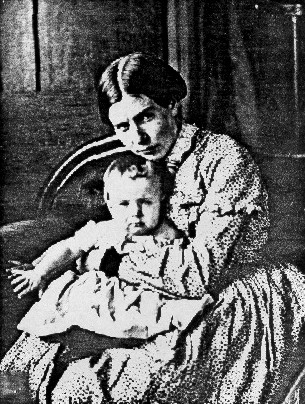
John Allen Gould III was the fifth child born to John A. II and Nancy on December 14, 1852. He was married to Frances Taylor Sabin on September 10, 1884 with the wedding taking place at her parents’ home on Main Street, Gardner, Massachusetts.
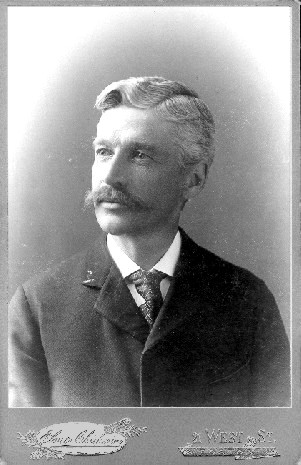
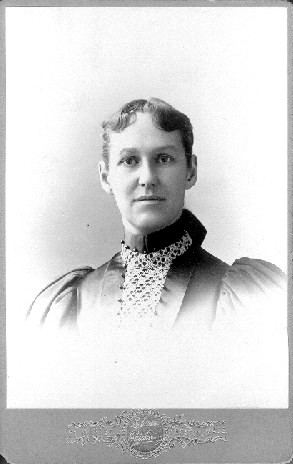
While it is thought that they set up housekeeping at l206 Boylston Street in Newton Upper Falls, an 1886 city atlas shows that this address was under the ownership of the heirs of one Miss C.L. Wheeler. However, this same atlas shows a new (?) house diagonally across (in an easterly direction) from 49 Rockland Place owned by John A. Gould, Jr.(III) with J.A. Gould Sr.(II) still shown as the owner of the property at 49 Rockland. An 1895 atlas does show that J. A. Gould III had acquired the property formerly owned by the Wheeler heirs whose address would be 1206 Boylston Street. This 1895 atlas shows that the property formerly occupied by John A. III on Rockland Place across from #49 was now owned by Melvin W. Gould, John A. II’s youngest son.
Melvin Gould was born December 2, 1855 and was married to Lydia Toulmin, who was born in 1858 and died in 1894. Melvin died in 1835 and both he and his wife are buried in Newton Cemetery. The Newton City Directory for 1883 indicates Melvin was working at 87 Milk Street in Boston and boarding at G.B. Randalls, whose home was on Boylston street near High Street. An 1885 directory shows him working as a teller at 87 Milk Street, Boston with his home being on Rockland Place.
In any event, John Allen Gould III and his wife Frances Taylor (Sabin) Gould would have six children, five sons and one daughter, born here at 1206 Boylston Street.
Their first son, Gardner Sabin Gould was born April 16, 1886 and died June 29, 1973. On September 14, 1910 he was married to Nina Green Clapp. At the outbreak of World War I, he was the father of a four-year old daughter and doing civil engineering work for the Navy at Newport, Rhode Island, and thus was the only son not to enter some branch of service during the war.
Allen Adams Gould was the second son, born December 14, 1887. He was sent to France as an Army Captain to work for the British Ministry of Munitions. He married Barbara Venning on April 3, 1943 and he died in 1972.
Richard Hartshorn Gould was the third son, born June 14, 1889. He served in the war as a pursuit pilot in France and was married to Anna K. Spenser. He died in 1977.
Prescott Wilder Gould, the fourth son (born February 23, 1894), after a short period of service in the cavalry on the Mexican Border in pursuit of Pancho Villa, became a machine gunner sergeant in World War I. Not long after participating in the battle at Siecheprey, France, he ironically became ill from intestinal complications, resulting in his death on May 16, 1918.
The youngest son, Howard Paine Gould was born January 30, 1898. He served aboard one of the Navy’s subchasers, mostly in European waters. He was unmarried and died at the young age of 30 on November 29, 1928. A 1923 city directory indicates that he was employed in the marine insurance business at Kilby Street, Boston.
Margaret Sylvester Gould, was born June 14, 1899. She was married on February 14, 1933 to George Bancroft Hall and she died May 5, 1982.
John Allen III and his family attended the Upper Falls Methodist Church. It is reported that it was a very exciting Sunday morning the time he pulled up in front of the church in a Stanley Steamer and it blew up. It is not known whether anyone was injured in the explosion.
Besides acting as a director of the Merchant’s Cooperative Bank,. Mr. Gould was a member of the Boston Society of Civil Engineers, the New England Waterworks Association, the New England Association of Gas Engineers, the American Gaslight Association and the Guild of Gas Managers. He was also the treasurer of the Quinobequin Association and the Newton Upper Falls Improvement Association.
It is recorded that John A. Gould III constructed a home on Rockland Place for his wife’s unmarried sister, Ethel Wheeler Sabin, from a barn on his property but during the remodeling process a workman accidentally set the structure on fire. It is true that an earlier city atlas (1874) shows a large barn to the rear of the property at 1206 Boylston, but the 1886 atlas does not indicate one there. It is believed that it was replaced later by a home (18 Rockland Place) which became the residence of Miss Sabin.
The father of this family, John Allen III, died on May 18, 1919 while most of his sons were in the service. His wife, Frances, died January 6, 1943.
Additional Information
The following are items that are not included in the biography of the Gould family.
They are taken from the same diary and journal kept by its author, Major John Allen Gould I. These are items that are of a different nature than family records, but which we thought were of enough interest to be included here. Major Gould began his journal in the year 1843; any items prior to that time are just recollections of the events. We will try to confine them to only records of items of national interest and those of unusual local and domestic events.
1796
When between ten and eleven years of age…my residence in Quincy was at the time when John Adams, an inhabitant of that town, was first Vice President and then President of the United States. I had frequent opportunities of seeing Mr. Adams at church and other places. I recollect of once selling him some fresh fish…. Mr. Adams was of middling height, thickset and fair looking.
1815
About the middle of February our ears were greeted with the news of peace between this country and Great Britain. This ended the War of 1812.
October 24, 1843
I went to Dedham to hear John Q. Adams, formerly president of the United States but now Representative to Congress deliver an address to his constituents. I with many other persons had the pleasure of being introduced to Mr. Adams and shaking hands with him. The address was delivered in the meeting house of Mr. Burgess. It was interesting to see Mr. Adams who had been the President of the United States in a pulpit addressing his countrymen upon subjects of national concern and welfare. Mr. Adams was then 76 years old.… His voice was quite clear and distinct.
Sept. 20, 1848
Went to Boston on business. On my return stopped at a meeting of Whigs in Dedham (John had earlier gone as a delegate to the Whig convention at Worcester) and heard an address delivered by Hon. Abraham Lincoln, a member of Congress from the State of Illinois. The address was strongly in favor of Gen. (Zachary) Taylor for the presidency of the United States.
November 7, 1848
This is the day established by a recent law of the United States for the people of the several states to choose Electors of President and Vice President of the United States. Under former laws electors were chosen at such time as each state might direct.
September 9, 1850
Congress have, after about six months debate and contention voted to admit
California as a State into the Union, with a Constitution which prohibits Slavery within its limits.
September 6, 1852
Was engaged in giving names to the several streets in the town of Walpole.
September 28, 1852
Attended a Whig Convention at Dedham as a delegate from Walpole to nominate a candidate for representative to Congress. At this convention I had the pleasure of meeting my son George as a delegate from Newton to said Convention.
September 16, 1853
Took charge of the removal of four Lunatics from the jail in Dedham to the Lunatic Asylum in Vermont. This vas my first visit to the State of Vermont, and adds another to the list of States which I have been into, namely, Massachusetts, Maine, New Hampshire, Vermont, Rhode Island, Connecticut, New York and New Jersey, making in all eight States.
January 1, 1854
New Years day. I have had rather a busy time the past year. I have continued my charge of two estates and commenced on the estate of the third individual. I have served as Special County Commissioner, Chairman of the Boards of Selectmen, Assessors and Overseers of the Poor of the town of Walpole together with incidental business.
FRANK JUDSON HALE
Much of the following information regarding Mr. Hale is taken from the book, BEAUTIFUL NEWTON, publisher John C. Brimblecom, Newton Graphic Publishing Company, Newton, Massachusetts.
Frank Judson Hale was the General Manager and Director of the Saco-Lowell Shops and was considered to be one of the more successful business men residing in Newton. He was born in Newton Upper Falls, Massachusetts, August 14, 1862, the son of Amos L. and Tamson Drake Hale. He was educated in the Newton schools.


Besides his interest in the Saco-Lowell shops, Mr. Hale was a director of many companies including a number of cotton mills. In local affairs he was a director of the Newton Trust Co., the Newton Cooperative Bank, and the Newton Home for the Aged (now The Stone Institute). He was also a trustee of the Newton Savings Bank.
He served on the Common Council of Newton in 1888 and 1889, resigning in June of that year to accept an election to the school committee, where he served until December 31, 1898.
Mr. Hale was married to Grace E. Herrick and they had two children, a daughter Marjorie and a son, Roger Drake Hale. Mrs. Hale, who had been a school teacher, was the daughter of Reverend Austin F. Herrick who at one time served as pastor of the Newton Upper Falls Methodist Church.
WILLARD MARCY
The Boston area Marcys were descended from John Marcy who emigrated to Roxbury in 1683.

Willard Marcy, the eldest son of Buckley Marcy was born in Hartland, Vermont, November 21, 1822. He received his education in the rural district school of Hartland. After working on the home farm until he was twenty-two years old, he moved to Medfield, Massachusetts where he was employed by Mr. Dennis Hossington traveling in a Tin cart, for which he received wages that amounted to only thirty cents a day. But it is said he was so diligent in his business and so frugal that at the end of three or four years he was able to partially pay for a stove and tin shop business in Newton Upper Falls. On January l, 1850 he married Maria Farnum of Cumberland, Rhode Island. Unfortunately, she died the following year, in October 1851. He was so overcome with grief at the loss of his wife that he suffered a severe illness and almost a year passed before he recovered. He sold his business at Newton Upper Falls and returned to his father’s farm in Hartland, Vermont but after a period of convalescence he returned to Upper Falls where he operated a grocery store for a period of nine or ten years. During this time he became interested in town affairs and held many appointed and elective offices, from that of village constable to the position of Selectman, later serving on the Board of Assessors and holding the office of the Overseer of the Poor.


For two or three years Willard Marcy held a position in the custom service under Collector Goodrich of the Port Of Boston. Becoming interested in the New York & Boston Railroad (formerly Charles River RR) which had already been built as far as Upper Falls, he resigned his government position in order to assist in extending the railroad as far as Woonsocket, Rhode Island where it merged with the New York & New England Railroad. Also, for a period of twenty years he held the position of wharfinger of Boston Wharf. He also served in the Massachusetts Legislature for two years, 1885 and 1886. From the date of its incorporation he was an officer and stock holder in the Newton Savings Bank and at the time of his death was a member of its Board of Trustees. He also was a trustee of the Methodist Episcopal Church at Newton Upper Falls.
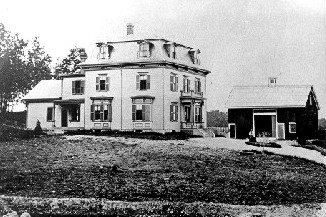
One of the greatest efforts of his life was his attempt, during a period of twenty years, to recover the principal of $371,000 taken by the United States government from a Newtonville bank in which he held an interest, at the time of the defalcation of its treasurer. The entire amount was eventually recovered, largely through his efforts.
On December 16, 1855 he married, as his second wife, Elizabeth Pettee of Newton Upper Falls. They had four children. The first, Maria Elizabeth, was born April 17, 1858 and died January 19, 1860.
The second, Mary Maria, was born October 11, 1859 and married Eugene L. Crandall of Claremont, New Hampshire. They had two children, Eula Viola, born December 16, 1887 and a son, Leslie Eugene, born September 21, 1890, who died March 10, 1891. Mary Maria died November 7, 1883.
Their first son, Willard Adna, was born October 15, 1870, and died June 10, 1937. In 1915 he married Jane Locke who was born December 18, 1874 at Seabrook, New Hampshire. They had two sons; Willard, born September 27, 1916 in Newton, Massachusetts.and John Locke, born and died in 1918 in Newton. The family moved to Syracuse, New York in 1922 but all are buried in Newton Cemetery. Willard Adna, a mechanical engineer, graduated from Massachusetts Institute of Technology.
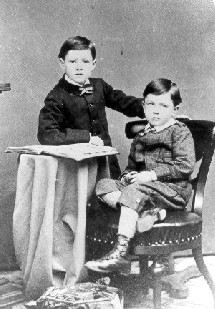
Their second son, George Leonard, born April 17, 1873 at Newton Upper Falls. George graduated from Bryant and Stratton Commercial School at Boston. He was married October 5, 1905 at Eastport, Maine to Dora Bessie Powell, born July 13, 1880 at Alma, New Brunswick, Canada, who died August 7, 1969. He and his wife had eight children, four girls and four boys, whose name are given next to his picture:
- Dora Elizabeth, born February 8, 1907, married Karl Darrow;
- Esther, born April 29, 1908, unmarried, died November 7, 1955;
- Mildred. born May 9, 1909, unmarried;
- George Louis, born November 10, 1911, married Mary Arbuckle; (photo at right)
- Gilbert, born July 7, 1913, married Eunice Phelps;
- Richard Powell, born October 22, 1914, married Hilda Underwood;
- Forrest Kinsman, born June 3, 1917, married Lillian Larsen;
- Ruth Pettee, born May 21, 1923, married Charles Neal.
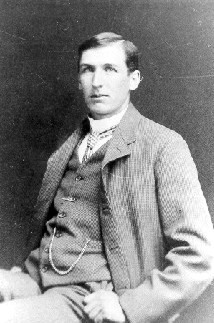
George died at the homestead where he was born on December 28, 1934.
Perhaps, with Willard Marcy’s investment in the local railroad, it was a bit ironic that on a morning in 1890, just after boarding the train on his daily commute to Boston, he was struck down with a fatal heart attack. On the day of his funeral “the business portion of the neighborhood was closed in respect to his memory.” The Upper Falls Methodist Church, of which Mr. Marcy was a member and trustee, was filled with members of his family and a host of friends representing all walks of life, dignitaries of state and a large number of city and village officials. There was no question that his passing represented a great loss to the community.
THE PARKER FAMILY
The Parker family came to Upper Falls shortly after the turn of the seventeenth century. Our first record of the family begins with the settlement of Samuel and Sarah {Holmar) Parker in Dedham in the early 1600s. Their son, Samuel, came to Newton in the 1690s and raised his family there.
Samuel Parker married Margaret, daughter of Captain Noah Wiswall, settled on part of the Wiswall land and in 1694 bought the house and land of Lieutenant Ebenezer Wiswall. In 1708, for the sum of 12 pounds, he acquired from John Clark at Upper Falls, a quarter part of the sawmill, water rights and half an acre of land. In 1717, at a cost of 45 pounds, he purchased another quarter part of the mills and an additional one and a half acre of land. He later acquired half ownership of the grist and fulling mills, including the land.
Samuel’s brother Nathaniel, who was born 1670, came to Newton about the same time.
Samuel and Margaret’s son, Noah, married Sarah Cummings of Tyngsboro in 1715 and settled in Newton Upper Falls. By “deed of gift” his father conveyed to him in 1725, half ownership of the saw, grist and fulling mills, valued at 150 pounds. That same year he acquired a quarter share of the property from William Clark (John’s son) and a similar share from Nathaniel Longley, including an additional seven acres of land. This made Noah Parker the sole owner of all the mill property on the river in 1725.
It was Noah’s son, Thomas, who remained in the old homestead at Upper Falls. He was a town Selectman and a representative to the General Court for six years, commencing in 1777. It was he who assisted in framing the first state constitution in the nation (now the oldest such document in the world.) in 1779 which was ratified in 1780. He was long “a leading and influential man in the town.” According to record. he died March 27, 1812 at the age of 91.
THE PETTEE FAMILY
The Pettees were of early American stock, coming to Upper Falls from Foxborough, Massachusetts where the family had settled around 1750. They were a highly respected family, a versatile people made up of farmers, blacksmiths, millowners, storekeepers and accomplished musicians. One served as organist for the local Congregational church in Foxborough for over 50 years, and Herbert Pettee was the youngest drummer boy from New England in the Civil War. The Pettees were among the owners of early blast furnaces for the making of iron and Joseph, brother of Otis, cast the anchor for the USS Constitution.
Scattered throughout this book are numerous references to Otis Pettee. Some of the following may be repetitious, dealing mostly with information regarding his family, but is included here to make it more readily available for genealogical purposes.
Otis Pettee was born March 5, 1795, the son of Simon and Abigail (Jenkins) Pettee of Foxborough, and grandson of Samuel and Elizabeth Pettee. His father had six sons and five daughters, and his grandfather (born 1690) had seven sons and six daughters. Otis married Matilda Sherman September 25, 1817 and they had six sons and three daughters.
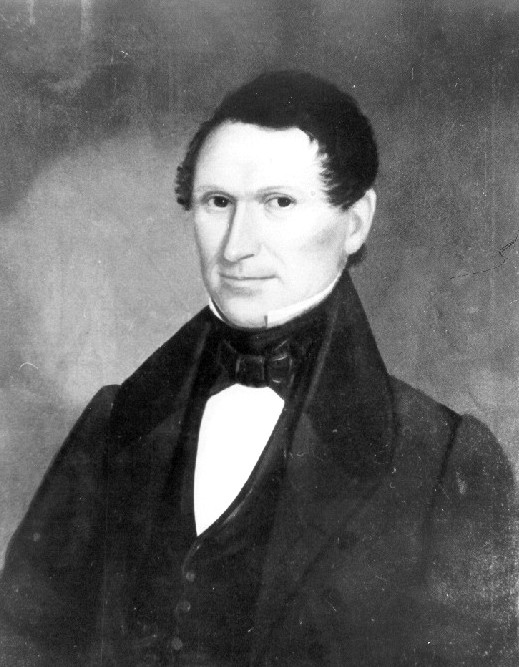

He died February 11, 1853 at age 58 leaving a fair estate of which the inventory, irrespective of business liabilities, was declared by the Judge of Probate to be the largest that had been filed in Middlesex County. The rise and fall of his business fortune was reflected in his will which showed the total value of his estate to be $232,175 but with debts totaling $84,003.
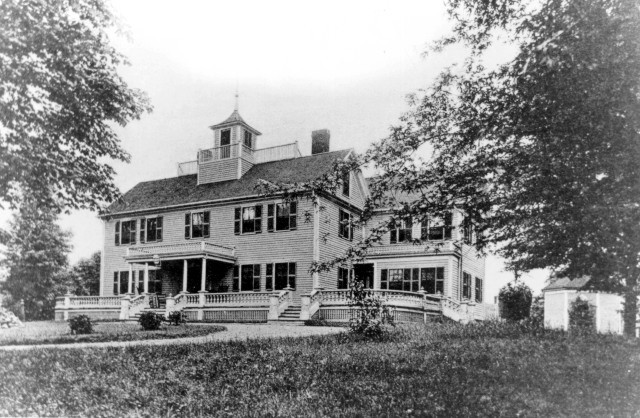
As late as two years before his death Mr. Pettee had raised $11,000 by placing a mortgage on his home. His property holdings were considerable. In Newton he owned a machine shop, 12 acres of land containing other shops, the Elliot Mills including all its machinery, and 15 other dwelling houses “mostly adapted to several families each.” Most of this, except for the Pettee Works was sold to help liquidate his debts. These sales yielded $90,501 or about $6,000 more than required. His personal estate of $105,339 was untouched.. It should. be noted that at one time he owned 30 dwellings in Upper Falls. His will also disclosed that he owned seven acres of land, a rolling and slitting mill, nail factory, sawmill and a gristmill in Needham.
Mr. McLaughlin adds the following regarding Mr. Pettee:
“Mr. Pettee had three sons [Six were born but three died in infancy….Ed] and three daughters: Elizabeth married Willard Marcy who built a farm house at 1173 Chestnut Street. Another daughter, Catherine, married Martin Sturtevant. He built a home at (59) High Street. He continued to live there with his daughter, Hattie, following his wife’s death in 1911. Hattie was the organist at the Methodist Church and also gave music lessons. The oldest daughter (Louisa) married Henry Billings. One son, Henry, graduated from Harvard and was a professor at Ann Arbor University until his death in 1901. Son George married Delia Wetherell, the daughter of the founder of the Wetherell Steel Company, Jacob B. Wetherell. He built a house on the corner of Hale Street and Pennsylvania Avenue, where he lived until his death in 1896, and where his daughter “Birdie” (Florence Bird Pettee) lived until her death in l932….”
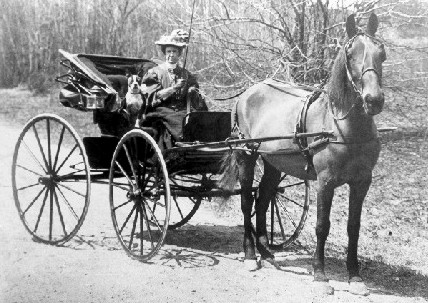
Children of Otis and Matilda were as follows:
| Name | Born | Died |
|---|---|---|
| Otis, Jr. | 07-06-1818 | 1823 |
| Louisa | 08-30-1821 | ? |
| Otis Jr. | 12-05-1823 | ? |
| Luther | 04-18-1826 | 1826 |
| Catherine | 11-25-1829 | 1911 |
| Elizabeth | 09-04-1831 | 1914 |
| George | 10-28-1827 | 1896 |
| Willian | 09-01-1834 | 1935 |
| William Henry | 01-08-1938 | 1901 |
Otis Pettee Jr. was born in Newton Upper Falls, December 5, 1823. He received. his education in the Newton schools and then entered the machine works with his father and became interested in the manufacture of cotton machinery, continuing in business until 1881. He had. a long and distinguished career in town and city government. He was Town Selectman 1857-58, 1870-73, Assessor 1862-64 , Town Auditor 1866-69, Alderman 1875, 1877-79 (President of the Board 1874-75. When West Newton became a city in 1874 Mr. Pettee was one of the two Selectmen to become Aldermen.

Otis, Jr. married Julia Maria Smith of Needham who was born October 4, 1824 and died April 27, 1891. During the last 15 or so years of his life, Otis kept a very informative diary and supplied a great deal of material for historical publications, some of which is contained in this book. They had one son, Otis Theodore Pettee.


Otis T. was born February 5, 1853 and died September 6, 1907. He, too, kept a diary the latter days of his life. The last entry was September 5 indicating that death was sudden. Many of these Pettee diaries may be found in the archives of the Jackson Homestead while others are in the possession of the writer.
Mr. McLaughlin writes concerning the son, Otis Theodore Pettee:
“Otis Jr.’s son, Otis T, who became Treasurer of the Gamewell Company, lived in the (Pettee) home until its purchase by the Stone Institute. He purchased considerable property in the Eliot section of Upper Falls and built a new home there, but he died before its completion. However, his widow, Grace (Maverick), born June 9, 1860 and a niece of Judge Grover of Dedham, lived there until her death.” [November 3, 1940. Ed.].
George Pettee was born in Newton Upper Falls October 28, 1827. He was educated in the local public school (See “SCHOOLS“), also attending a private school in Newton Centre operated by Marshall S. Rice for several terms. Later he entered Wilbraham Academy from which he graduated with honors. After leaving school he took charge of a bakery owned by his father. It was located in one ell of the large boarding house that once occupied a site on lower Mechanic Street (the building later known as the “Bee Hive“).

A few years later George became a clerk in his father’s grocery on Elliot Street, known then as the “back store”. Shortly after this he went into his father’s cotton machinery business and in the latter part of 1850 became Agent of the Elliot Mills. After his father’s death, the Elliot Mills passed into the hands of Mr. F.N. Weld. Six months later Mr. Pettee became a member of the firm of Otis Pettee & Co., assuming the position of General Superintendent. He retired from business following the purchase of the concern by his brother-in-law, Henry Billings.
George was very active in community affairs, serving nine years in the Common Council and six years as Alderman from Ward 5; the last four years serving as president of the board. Later he was nominated for Mayor but lost he election by 59 votes. For over 20 years he was a very active member of the Newton Fire Department serving in many capacities, finally as Chief in 1861 and later on the Board of Engineers. He resided for many years on Pennsylvania Avenue.
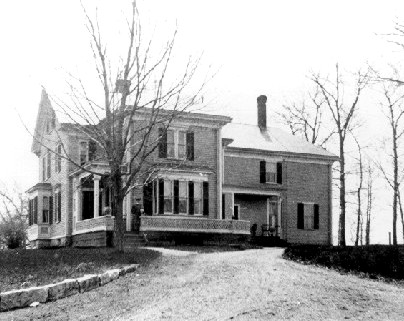
He died. June 15, 1896 at the age of 69 leaving a widow, the former Della Wetherell, daughter of Jacob B. Wetherell, as well as two daughters, Ethel D. and Florence B. Pettee.
William Henry Pettee, the youngest son of Otis Pettee, graduated from Harvard College and was the only member of the family to leave the village, traveling west where he became an instructor and assistant professor at various schools of mining and geology. In 1874 he returned to Upper Falls to marry a local girl, Sybil Anne Clarke, but in 1875 when the University of Michigan established a School of Mines and he was offered a professorship in mining engineering, he accepted the offer and served in that position for 29 years. Professor Pettee was one of the original fellows of the Geological Society of America, a Fellow of the American Association for the Advancement of Science, a member of the American Academy of Arts & Sciences, and the American Philosophical Society.

He died in 1904 leaving his wife and his daughter, Sybil Matilda Pettee, who later married Earle W. Dow. Sybil Pettee Dow and her husband became residents of Nebraska and had three children, Philip, Jean and David. . She inherited portraits of her grandparents, painted in 1837 at Newton Upper Falls by an itinerant painter (see photos), which she later donated to the University of Nebraska where they were hung in the Sheldon GalIery. At present they are displayed in the foyer of the governor’s mansion. They are treasured by the university as they represent a certain period of American folk art of which they have few examples.
As indicated earlier, Louisa, Otis Pettee’s oldest daughter, married Henry Billings who eventually acquired the firm of Otis Pettee & Co. He built a large home on Pettee property next door to that of his father-in-law. Louisa and he were married November 25, 1841 and they had three children; Louisa Matilda, born March 3, 1843; Henry Otis, born May 29, 1846 and Mary Josephine, born September 24, 1848.
Also, as indicated earlier, daughter Catherine married Martin Sturtevant and they had one daughter, Hattie.
Again, as previously indicated, the youngest daughter, Elizabeth married Willard Marcy who was a local business man and part owner of a paper mill. He was a descendant of the Marcy family, one of the eleven families which settled Roxbury in 1683. His family home was located in Hartland, Vermont. (See further information in bibliography of WILLARD MARCY).
We close with a final tribute to Otis Pettee taken from Henry K. Rowe’s book, “Tercentenniery History of Newton” He writes,
“Until his death in 1853 Otis Pettee was one of the principal factors in the development of Newton. He not only furnished employment to hundreds of men and used his good judgment and spirit of enterprise to further the interests of the community in a business way, but he sympathized with the temperance and slavery reforms that were being agitated, and his sterling character was a power among his acquaintances.”
Otis Pettee’s gravestone in Newton Cemetery bears this testimony:
| AN UPRIGHT MAN OF DEEP INVENTIVE GENIUS SOLID JUDGMENT, GREAT ENTERPRISE AND BENEFICENT HEART |
MARSHALL S. RICE
Marshall S. Rice was born June 10, 1800, the son of Nathan Rice, a practicing physician who, soon after Marshall was born, took his family to East Sudbury (which became Wayland in 1835). Later the family moved to Newton Upper Falls, and an 1831 map shows a “Rice” home located at the top of Boylston Street Hill on the north side.
Marshall’s first education was in the district schools of Wayland. In his later grades when the master, a physician, was called to attend the sick, Marshall would take his place; this experience led him to become interested in the profession of teaching. After working on a farm for two or three years, he decided on a career of teaching, which led him to enter the academy at Westford, where he studied for a single term. In the winters of 1821-1823 he taught a district school in Wayland at a salary of $16-$18 a month, working on the farm during the summers. In 1824 he took charge of one of the schools in Dorchester which was kept open throughout the year. In May, 1824 he commenced a boarding school for boys at Newton Center which he continued for 23 years.
It is believed that the Rice family moved to Upper Falls about 1826 since Dr. Nathan Rice and his wife, Mary, are listed, along with their sons, Gardner and Marshall, as members of a “class” of Methodists here in that year. Gardner was a teacher at the Holliston Academy in Massachusetts and was later ordained a minister.
With his purchase of the Upper Falls Religious Society (Unitarian) Church in 1836, Marshall became the founder and member of the First Methodist Episcopal Church in Newton, and remained a member and supporter of the church from 1832 until his death in 1879. He was also the superintendent of its Sunday School for that same period. He was Selectman and the Town Clerk of Newton for 27 years, holding this office – the last of a series – until the town became a city in 1874. He was also Representative to the General Court for four years commencing in 1846.
He was twice married and had five children. One of them, a son and the youngest, died in the Civil War. The eldest daughter died in 1847. The second daughter married Reverend Alvah Hovey, president of the Newton Theological Institution (presently the Andover Newton Theological School) and the third married Reverend C.H. Carpenter who was a missionary to Burma.
Mr. Rice died February 21, 1879.
LEVI C. WADE
After graduating from Yale in 1866 Levi Wade came to Newton to study theology, enrolling in the Newton Theological Institution at Newton Centre. However, he had a change of mind and three years later came to Newton Upper Falls to teach school. He became the first master of the Prospect #2 school that was built in 1869. [See section under “SCHOOLS” for story of change of name of Prospect St. school to that of “Levi C. Wade” and the gift of Mrs. Wade after the death of Mr. Wade that never materialized.] He continued to serve in this position until 1873 when he left to enter the practice of law in Boston. The 1874 atlas of Newton shows Mr. Wade’s residence to be at 1198 Chestnut Street in Newton Upper Falls with the following notice appearing in the advertising section: “Levi C. Wade., Atty. and Counsellor at Law, 68 Cornhill, Boston. Residence, Chestnut St.,, Newton Upper Falls.” His home was later occupied by John Brundrett and was located near what was later known as Ackroyd’s Block. The atlas shows that Mr. Wade was also owner of this building which was later replaced by a business block containing the present Newton Beverage Shop and one other business enterprise.
In 1877, he and the Honorable J.Q.A. Brackett, who was later Lieutenant Governor of Massachusetts, formed the law firm of Wade and Brackett. While residing in Upper Falls, Mr. Wade represented Newton in the General Court for four successive years, becoming Speaker of the House of Representatives in 1879. Refusing reelection, he devoted himself to railway law and management. He was one of the four original developers and owners of rail lines that later became the Mexican Central Railway Company, and for many years served as its president and general counsel. He was also associated with a U. S. railroad., called, at the time, the Cincinnatti, Sandusky & Cleveland RR. At this time he was also acquiring considerable acreage in Oak Hill, and about 1883 he built a large country house with great chimneys and gables. It was located on Dedham Street near Parker Street, and the estate covered over 200 acres. He called it “Homewood”.
Mr. Wade was married in Bath, Maine in 1869 to Margaret Rogers. They had four sons, Arthur C., William R., Levi C. Jr., and Robert. Mr. Wade died at Oak Hill on March 21, 1891.
THOMAS W. WHITE
This very colorful character was engaged in local business as well as in state and national politics. He owned and operated a drug store in the Prospect Block at the corner of High and Pettee streets for a number of years. He was successful and acquired other stores in Needham, Newtonville and Chestnut Hill. He became active in politics starting in Newton as an Alderman from Ward Five. This led to full time activity in state politics and he sold all of his stores mostly to his assistants, one of whom, Thomas Aiken took over the local store.
By appointment of Governor David I. Walsh he was made Commissioner of Administration and Finance and later became Collector of Internal Revenue in Boston for the federal government, During the Calvin Coolidge administration, he was considered Mr. Coolidge’s “Uncle Thomas”, and served as unofficial advisor and unpaid assistant. He was active the campaigns of Senators Saltonstall and Lodge. In his later days he helped organize the Suffolk Downs racetrack and was one of its owners. In 1950 he was severely crippled by a fall; he died in 1960.
THE WINSLOWS OF UPPER FALLS
Among the families who exerted a great deal of influence and shared in shaping the development of the village of Upper Falls during its formative years were the Winslows. They were the lineal descendants of Edward Winslow of Droitwich, England who died in 1631. He was the father of Governor Edward Winslow who with his brother, John, came on the Mayflower in 1620. The Winslows’ American ancestor was Kenelm Winslow, a brother of the governor and of John, who came to Plymouth about 1630, probably on the Mayflower’s second voyage. Starting with Edward Winslow of Droitwich, England the lineal line runs thus: Kenelm (son of Edward), Kenelm, Josiah, James, Shadrach.
The vital statistics of each member of the Winslow family, and also any other information of interest are taken from the Winslow Family Genealogy on file in the New England Historic Genealogical Society in Boston. Although they are lengthy we include them here for the benefit of Winslow family descendants. Our record begins with Shadrach, who seems to have reinstilled the spirit of adventure into some of his descendants.
Dr. Shadrach Winslow was born December 17, 1750 in Freetown, Massachusetts and he died in Foxboro, Massachusetts February l, 1817 at the age of 66. He graduated from Yale in 1771 and became an eminent physician and surgeon. It must be noted that in 1776 only about 400 of the 3500 colonial physicians had medical degrees. During the Revolutionary War he fitted up an American privateer on which he sailed as a surgeon. He was taken prisoner and held off the coast of Spain and afterwards, for a period of one year, was a prisoner on board the “Old Jersey Prison Ship” in Wallabout Bay, Brooklyn. He suffered many privations and his health was impaired. On March 12, 1783 he married Elizabeth Robbins. She was born April 29, 1764 at Foxboro, the daughter of Eleazer and Mary (Savell) Robbins. She died April l, 1846 at Foxboro.
Shadrach’s son, Eleazer was one of 10 children who possessed some of his father’s adventuresome spirit. He was born March 21, 1786 at Foxboro, Massachusetts and he died August 8, 1863 at Newton Upper Falls (age 77) and is buried in Newton Cemetery. He married Ann Corbett of Boston on April 21, 1811 when she was but 17. Her father, David Corbett, was born in July, 1767. Her mother, Deborah, the daughter of David and Deborah (Cowin) was born December 2, 1768. David and Deborah were married December 2, 1792. They had five sons and four daughters although two of the girls died quite young.
In 1814 they had their first child, Charles, while living in Mansfield, Massachusetts. Supposedly because of Eleazer’s poor health they went to live in a cabin in the township of Hunter, New York, located in the Catskill Mountains. Eleazer’s livelihood was the hunting of bears and wolves for which the state of New York paid a bounty. His wife later told of many harrowing experiences while living there. She was often compelled to pass the night alone with her growing and helpless children (five were born in this wilderness), her husband being absent on his trapping expeditions. The howling of the wolves around their lonely log cabin was by no means pleasant music to a woman born and educated in the city of Boston. The family then moved to Ramapo, New York where three more of their offspring were born. In 1826 they moved to Newton Upper Falls where seven more children were added. to the family. Of their 16 children, four did not survive to adulthood.
Ann arrived in Upper Falls when she was 33 years of age and was glad to be back within visiting distance of her family in Boston. Although her father had died In 1807, her mother died August 11, 1835.
Upon arriving in Upper Falls, Ann Winslow made her presence felt in this fast developing community. Concerned with the lack of organized religious activities in the village, she helped organize the first Methodist class in Newton in 1826 and was an active member of this faith until she died on September 24, 1871 at the age of 77. Her strong and steadying influence was reflected in the character and careers of her family.
The eldest Winslow son was Charles, born January 30, 1814 in Mansfleld, Massachusetts. He was married in Newton on February 18, 1838 to Sarah Ann Fuller who was born in Needham August 8, 1814. She was the daughter of Ezra and Mary (Woodcock) Fuller who had two other daughters, Mary Ellen born in Newark, New Jersey who died in her fourth year at Needham and Eleanor Isabel who was born January 20, 1852 at Springfield, Massachusetts. Charles was 12 when the family moved to Newton Upper Falls and presumably he finished his elementary schooling there. Included in remarks he made later at a reunion of former pupils at Holliston Academy in 1875 (under headmaster Gardner Rice, later a minister , and brother of Marshall S. Rice of Newton Upper Falls) was the statement that he had attended High School (Academy ?) “in the old Town Hall” for three terms. His residence in 1877 was Worcester and his occupation was that of a machinist. It appears that he had joined his brother Samuel who had established. a machine shop in Worcester in 1855.
Samuel Winslow was born February 28, 1827 at Newton Upper Falls. He married. Mary Weeks Robbins, born November 12, 1825 in Union, Maine to David and Lydia (Maxey) Robbins on November l, 1848. They had. two children, Frank E., born May 16, 1852 in Newton and Samuel E., born April 11, 1862 at Worcester. Samuel was to find himself a poor student but a good mechanic, and at an early age began what later became a lucrative career when he established machine shops in Worcester for the manufacture of ice and roller skates. Roller skating had become quite popular in the early 1860s when John Plimpton invented a method of converting an immovable skate to one which would respond to a curve. By 1871 the sport became popular nationally and when three years later it was received with similar enthusiasm in England, the output of 2,000 pairs a week in Plimpton’s factory in Brooklyn could not keep up with demand, he sought out Samuel Winslow, now a successful ice skate manufacturer, asking for his help in producing roller skates. During the next five years Winslow produced 20,000 pairs for Plimpton at $2 a pair. Later when he began manufacturing skates in his own right, he became the world’s largest roller skate manufacturer.
An Upper Falls news item appearing in a Newton paper on November 2, 1894, not long after his death, gives a detailed. record. of his achievements:
Hon. Samuel Winslow, who died at Worcester a few days ago, was once a resident of this village. He was Mayor of Worcester for many years, and was the father of the chairman of the state Republican committee. He was born in this village February, 28, lS28 (another record says 1827), and was one of sixteen children. He received a scanty education in the schools here and in 1855 started a machine shop in Worcester where he made a few pair of skates a day. He had continued in this business, taking in the rolling skate business which yielded him a handsome fortune, in addition to one already acquired by the manufacture of ice skates. He was president of the Citizens National Bank and Trustee of the People’s Savings Bank. During the last years of his life he had interested himself in the electric railways running out of Worcester, being president of all the roads.
Samuel’s earlier home was on High Street next to the present Emerson School, a fact which, combined with his rise to such prominence as indicated above, resulted in his name being suggested for the new school built next door to the property in 1904. However, the honor was finally awarded to that distinguished figure in American literature, Ralph Waldo Emerson.
Seth Collins Winslow was born January 11, 1822 at Ramapo, New York and died January 30, 1870 at Worcester, Massachusetts. He was married November 26, 1846 to Nancy M. Flagg who was born December 25, 1825 at Grafton, Massachusetts. She died May 17, 1850. Seth’s second marriage was March 30, 1854 to Eunice H. Swan who was born on September 13, 1827 at West Halifax, Vermont, the daughter of Salmon and Miriam (Harris) Swan. She died August 20, 1870. Seth and Eunice had six children, all born in Worcester.
The youngest son, James, lived but a short time; he was born August 2, 1834 at Newton Upper Falls and died there March 8, 1841.
Some information on son John Winslow has already been presented. We are indebted to him for the written record he left behind containing comments of different aspects of village life in Upper Falls, especially during the first half of the nineteenth century. Most of these are spread throughout this book under each chapter, particularly the one entitled “SCHOOLS.” A similar record is available to us, one kept by George Pettee who was the son of millowner Otis Pettee. The use of these records has been explained earlier in this book, and individual excerpts appearing in various chapters credited to the writer responsible for them.
John Winslow was born October 21, 1825 at Ramapo, Rockland County, New York and came with his parents to Newton Upper Falls when he was but sixteen months old. He was married at Bay Ridge, New Utrecht, Kings County, Long Island, New York December 27, 1854 to Sarah Miller Bennett, born November 22, 1825, daughter of John I, and Hannah (Baker) Bennett of Bay Ridge. They had two sons and a daughter; the older son died young and he is interred with his father and mother in Newton Cemetery.
David Corbett Winslow was born June 9, 1819 in the township of Hunter in the Catskill Mountains. He was married in New York City July 25, 1841 to Harriet Adaline Stearns. She was born January 14, 1817 in Franklin, Massachusetts, the daughter of Deacon Edwin and Harriet (Paddock) Stearns of Millbury, Massachusetts. They had eight children, four boys and four girls, all born in New York state. As a youth, David followed a different path than brother John. He attended the Upper Falls school for the most part in the winter. At the age of 20 he attended the academy at Hancock, New Hampshire for six months where he qualified to become a teacher. He taught his first school at Peterboro, New Hampshire during the winter of 1840-1841. In the spring of 1841 he moved to Long Island where he taught school and studied law at the same time. In due time he passed the bar examinations and was admitted to the bar in Brooklyn where he set up his own law practice. Soon after, his younger brother, John, became his partner in the firm. Like John, David also held many responsible positions in fields allied to his profession
The lengthy story regarding the last of the sons, George, will be included in the story of the California Gold Rush of 1849 found in the chapter VILLAGE LIFE.
We continue with a brief background of the nine Winslow daughters, taking them in the order of their ages.
Ann was born July 13, 1815 in Hunter Township, Green County, New York and died there April 16, 1816.
Elizabeth Robbins Winslow was born October 24, 1816, also in Hunter Township. She died April 21, 1824 in Ramapo, New York.
Clarissa Williams Winslow was born March 13, 1818 in Hunter Township and died at the age of 51 on July 29, 1869 in Newton Centre, Massachusetts. She was educated in the two-teacher, two room school in Upper Falls, became a teacher and later presided over the same classroom in which she had once been a pupil. She was married in the local Methodist church on Thanksgiving Day, November 31, 1843 by Gardner Rice (schoolmaster to some of the Winslow boys) to Brackett Lord who was born January 4, 1819 in Ossipee, New Hampshire, the son of Wentworth and Sally (May) Lord. He died June 25, 1872. They raised a family of five children, three born in Upper Falls and two in Needham. Theirs was a classroom romance as Mr. Lord was also a teacher in the village school. He will also play a part in the California Gold Rush story.
Emeline was born November 4, 1820 in Hunter Township, New York. She was also married in the local Methodist Church, by Reverend James Mudge, to Orrin Whipple. They had a family of eight children, all born in Newton. Mr. Whipple was born April 15, 1818 in Richmond, New Hampshire, the son of Cyrus and Polly (Baker) Whipple. He became a well known contractor and builder in Newton Corner, also owning and operating a steam saw and grist mill there. He served as a Selectman in Newton for 13 years. Jackson Homestead’s booklet of “Newton’s Older Houses, etc.” contains a picture of their substantial home at 195 Church Street, Newton Corner, where it is believed all of their children were born.
Deborah Ann Winslow was born August 8, 1828 at Newton Upper Falls. She draws special attention as her marriage in Newton Upper Falls on January 25, 1848 to Nathaniel Ware Everett (born November 18, 1810 at Foxboro, Massachusetts) was to a cousin of Edward Everett (1794-1865) the well known clergyman, scholar, statesman, and orator of that period. Among other positions of honor, Edward Everett served as Secretary of State in the cabinet of Millard Fillmore, 13th president of the United States (1850-1853). (See biography “EDWARD EVERETT”). Nathaniel Everett’s mother was Abigail Caswell Pettee, sister of Upper Falls millowner, Otis Pettee. Nathaniel and Deborah had six children (three died young) all born in Newton Upper Falls.
Mary Pratt Winslow was born April 14, 1830 at Newton Upper Falls. She was married by Reverend Z.A. Mudge in the Methodist church on April 20, 1848 to David Jackson Staples who was born May 3, 1824 in Medway, Massachusetts, son of John and Dorcas (Reed) Staples. David’s lineage extended back to seventeenth century pioneers as, indeed, so did that of the Winslows. Mr. Staples’ adventures will be included with those involved in the California Gold Rush story. The Staples had five children, one born in Newton and the other four in California.
Elizabeth Robbins Winslow was a twin to Mary Pratt Winslow. She was, of course, born April 14, 1830 at Newton Upper Falls. and married Marcy Robbins, February 19, 1854. He was born July 13, 1830 in Union, Maine, the son of David and Lydia A. (Maxey) Robbins. They had three children, all born in Newton Upper Falls. Later they moved to Worcester and one suspects that Mr. Robbins joined the Samuel Winslow enterprises.
Martha Switzer Winslow was born April 14, 1832 at Newton Upper Falls. She married Elliot Littlefield of Newton on March 15, 1853. He was born January 9, 1823 in Hopkinton, Massachusetts, the son of Amory and Nancy (Gilmore) Littlefield of Holliston, Massachusetts. He was a carpenter. He and Martha had four children, one born in Holliston, one born in Newton Upper Falls and two in Newton Corner. On September 26, 1861 in Newton, Mr. Littlefield enlisted in the Union forces and was assigned to Company G, 1st Massachusetts Cavalry. He was taken prisoner by the Confederate Army on September 14, 1863, confined for a time in Libby Prison and then was removed to Florence and afterwards to Andersonville, where he died in 1864. Following his death his widow and children returned to live in Newton Upper Falls.
Harriet F. Winslow, the last born of Eleazer and Ann, was born July 25, 1836 at Newton Upper Falls, dying there at a young age on March 8, 1841, the same day as her brother James.
We conclude here with the background of the other Winslow in town, Jesse, brother of Eleazer and “uncle” to all the children. He was born May 25, 1794, presumably at Foxboro, Massachusetts, remaining there until he was 20 years of age. In 1814 he went to Greenwich, Connecticut where he resided about two years and in 1816 he moved to Richmond, Virginia, living there until 1821 when he moved to Walpole, Massachusetts. In June, 1823 he moved permanently to Newton Upper Falls. In 1830 he married Carolina Ray of that village. She was the daughter of Samuel and Chloe (Whipple) Ray of Upper Falls, formerly of Cumberland, Rhode Island. Jesse served the village twice for a total of nine years as Postmaster and the town as Selectman and Assessor. He was elected to the state legislature for two terms. (See Chapter PUBLIC SERVICE BUILDINGS).
At the Registry of Deeds in the courthouse at Cambridge may be found a record that indicates that in 1845 Eleazer Winslow bought a house and land on Elliot Street (an 1855 map shows this house to be one still standing at 314 Elliot), thus fulfilling a millworker’s dream to “procure a small lot of land and build themselves a comfortable little home.” Eleazer did not build the house (a little larger than small) but we are sure it more than satisfied him. On this same 1855 map a home shown next door to Eleazer’s on the easterly side bears the name of the owner, Charles Winslow, the eldest son of Eleazer and Ann. After Charles moved to Worcester, his home appears to have been eventually acquired by the Newton Cotton Mills and moved to its present location at 333-337 Elliot Street.
On High Street, the house (now #23) next to the location of the old Emerson School building, is shown on the 1855 map as being owned by S(amuel) Winslow, the son who went off to Worcester to literally “make his fortune.” It would appear from the record that the influence of this family was felt in the village of Newton Upper Falls for over half a century which helped shape some of its history. A quick scan of the local telephone book finds Winslows still located just outside the borders of the village in Newton and Needham and, almost within the confines of the old original Upper Falls village, a Winslow Road perpetuates the name.
- On viewing the portrait, Mr. Emerson’s niece declared that it was the best likeness of her famous uncle she had ever seen. It is presumed the city acquired the painting after the school was closed. ↩︎
